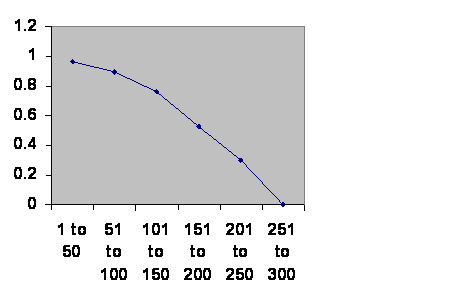
Information taken from R. H. Carling THE WORLD HISTORY CHART International Timeline Inc. Vienna, VA 1985. The experience of Southern Mesopotamia. The vertical axis is The chance of an empire of any age continuing to rule locally for another 50 years. The horizontal axis is the ages of the empires.
I think that’s pretty good for being predictable. If what took out a civilization was a characteristic of a civilization, the line should go up at some point because of selective effects. If civilizations fell because of climate change or other outside forces, the line would be horizontal. The line goes down, so the culprit is neither inside the population nor outside of it. It can only be the fact of a big population. Falling fertility would do it, wouldn’t it? And there would be a lag between peak population and unrest. The elite, the administrators, the guys who make things work have the broadest social horizon. Lose them and the society collapses.
There is more information at http://nobabies.net/Orlando%20meeting.html
But you get the general picture.
According to the article, you have found a cycle of civil unrest in America. So we are in agreement with the existence of cycles. I have cudgeled my brain, but I cannot come up with a fifty year cycle. So your data require more explanation than I can offer.
And a serious weakness of my model is that I cannot identify a starting point. The end is easy. It’s a regime change. They line up all the old elite and liquidate them. Blessedly this did not happen in Russia with the end of communism, but it happened at the beginning. Everyone remembers the Terror of the French Revolution.
Clearly there is a sort of brick wall as a civilization reaches 300 years. So it is probably about ten generations from leaving the village structure and founding an urban culture. That would mean a maximum population of about a thousand before trouble sets in. Looking at the decline of fertility with kinship in the Helgason study, nature puts the breaks on the population by the time kinship falls that low. So it all kind of works out. But it still leaves the question of how you identify the start. Would it be 1776 for America?
If so, the end should come in 2076. I imagine that the end is reached when the society – at least the administrative segment – consists only of people over fifty. So the last baby born to the original population of the United States would be close to 2026 or 14 years from now. If the mother of that last baby were going to be 40, she would be 26 by now and have no offspring. We would have noticed that, for sure. So that doesn’t seem to be the time we would be looking at for a regime change based on infertility. The soonest it would come would be if the youngest mother to be were 12, where there are not that many pregnancies anyway. Would leave the last baby being born in 2050 and collapse occurring toward the end of the century.
You have looked carefully, and I think brilliantly, at civil unrest and find a 50 year cycle expected to recur in 2020. I do not challenge your prediction. I think my own idea just does not apply. But I thought that since you are interested in population dynamics and history, you’d like to see my evidence. As I said, the relationship between kinship and fertility is established. What nobody has done in print is say, “Hey. If this happens to everybody, then it happens to the whole population, doesn’t it?” I don’t see why that leap is difficult, but apparently it is.